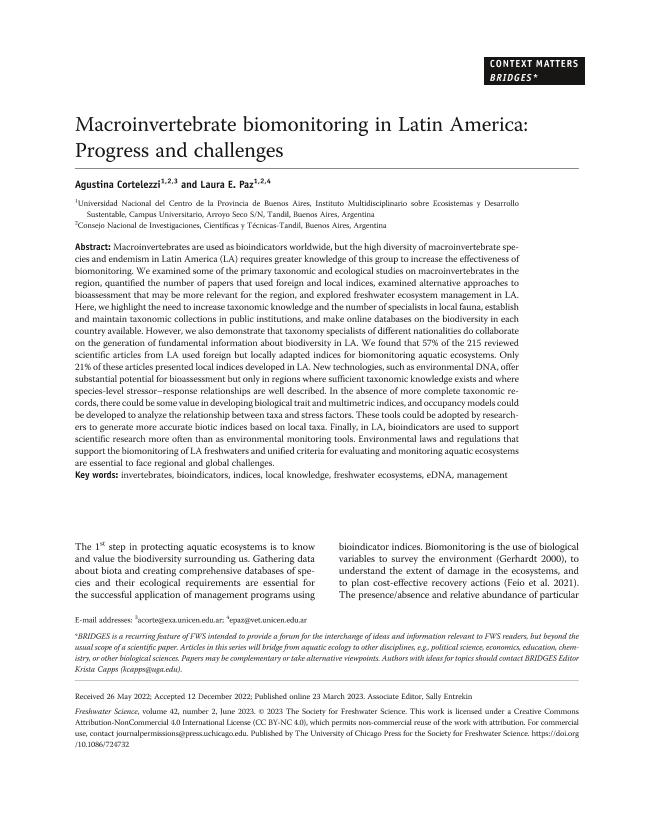Mostrar el registro sencillo del ítem
dc.contributor.author
Cortelezzi, Agustina

dc.contributor.author
Paz, Laura Estefania

dc.date.available
2024-01-24T18:07:07Z
dc.date.issued
2023-02
dc.identifier.citation
Cortelezzi, Agustina; Paz, Laura Estefania; Macroinvertebrate biomonitoring in Latin America: Progress and challenges; University of Chicago Press; Freshwater Science; 42; 2; 2-2023; 204-213
dc.identifier.issn
2161-9549
dc.identifier.uri
http://hdl.handle.net/11336/224761
dc.description.abstract
Macroinvertebrates are used as bioindicators worldwide, but the high diversity of macroinvertebrate species and endemism in Latin America (LA) requires greater knowledge of this group to increase the effectiveness of biomonitoring. We examined some of the primary taxonomic and ecological studies on macroinvertebrates in the region, quantified the number of papers that used foreign and local indices, examined alternative approaches to bioassessment that may be more relevant for the region, and explored freshwater ecosystem management in LA. Here, we highlight the need to increase taxonomic knowledge and the number of specialists in local fauna, establish and maintain taxonomic collections in public institutions, and make online databases on the biodiversity in each country available. However, we also demonstrate that taxonomy specialists of different nationalities do collaborate on the generation of fundamental information about biodiversity in LA. We found that 57% of the 215 reviewed scientific articles from LA used foreign but locally adapted indices for biomonitoring aquatic ecosystems. Only 21% of these articles presented local indices developed in LA. New technologies, such as environmental DNA, offer substantial potential for bioassessment but only in regions where sufficient taxonomic knowledge exists and where species-level stressor–response relationships are well described. In the absence of more complete taxonomic re-cords, there could be some value in developing biological trait and multimetric indices, and occupancy models could be developed to analyze the relationship between taxa and stress factors. These tools could be adopted by researchers to generate more accurate biotic indices based on local taxa. Finally, in LA, bioindicators are used to support scientific research more often than as environmental monitoring tools. Environmental laws and regulations that support the biomonitoring of LA freshwaters and unified criteria for evaluating and monitoring aquatic ecosystems are essential to face regional and global challenges.
dc.format
application/pdf
dc.language.iso
eng
dc.publisher
University of Chicago Press

dc.rights
info:eu-repo/semantics/openAccess
dc.rights.uri
https://creativecommons.org/licenses/by-nc/2.5/ar/
dc.subject
INVERTEBRATES
dc.subject
BIOINDICATORS
dc.subject
INDEXES
dc.subject
LOCAL KNOWLEDGE
dc.subject.classification
Otras Ciencias de la Tierra y relacionadas con el Medio Ambiente

dc.subject.classification
Ciencias de la Tierra y relacionadas con el Medio Ambiente

dc.subject.classification
CIENCIAS NATURALES Y EXACTAS

dc.title
Macroinvertebrate biomonitoring in Latin America: Progress and challenges
dc.type
info:eu-repo/semantics/article
dc.type
info:ar-repo/semantics/artículo
dc.type
info:eu-repo/semantics/publishedVersion
dc.date.updated
2024-01-24T15:24:14Z
dc.identifier.eissn
2161-9565
dc.journal.volume
42
dc.journal.number
2
dc.journal.pagination
204-213
dc.journal.pais
Estados Unidos

dc.journal.ciudad
Chicago
dc.description.fil
Fil: Cortelezzi, Agustina. Consejo Nacional de Investigaciones Científicas y Técnicas. Centro Científico Tecnológico Conicet - Tandil; Argentina. Universidad Nacional del Centro de la Provincia de Buenos Aires. Facultad de Ciencias Exactas. Instituto Multidisciplinario de Ecosistemas y Desarrollo Sustentable; Argentina
dc.description.fil
Fil: Paz, Laura Estefania. Consejo Nacional de Investigaciones Científicas y Técnicas. Centro Científico Tecnológico Conicet - Tandil; Argentina. Universidad Nacional del Centro de la Provincia de Buenos Aires. Facultad de Ciencias Exactas. Instituto Multidisciplinario de Ecosistemas y Desarrollo Sustentable; Argentina
dc.journal.title
Freshwater Science
dc.relation.alternativeid
info:eu-repo/semantics/altIdentifier/doi/https://doi.org/10.1086/724732
dc.relation.alternativeid
info:eu-repo/semantics/altIdentifier/url/https://www.journals.uchicago.edu/doi/10.1086/724732
Archivos asociados
